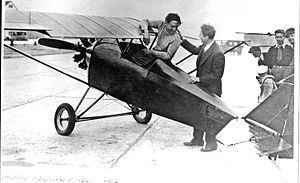First flight May 1931 | ||
 | ||
The Terle Sportplane was an original homebuilt design built by Joseph Terle, who had no prior aircraft design experience.
Contents
Design and development
The aircraft was developed from aviation articles and magazines between 1929 and 1931. The airfoil was copied from the Spirit of St. Louis profile.
The Terle Sportplane is an all wood parasol taildragger powered by a Salmson radial. After an accident with the prototype, the fuselage was changed to welded steel tube with aircraft fabric covering.
Operational history
The Sportplane was tested at Roosevelt Field in New York in 1931, but the CAA did not register it as a licensed aircraft. The aircraft was later test flown by the famous test pilot, Bert Acosta, who found it perfect for his use since he was currently grounded from flying licensed aircraft by a previous infraction. After performing aerobatics with the aircraft before a large crowd, Acosta and Terle planned to produce the aircraft together as the "Acosterle Wildcat". The aircraft was test flown for two years, but could not meet certification requirements. The JT1 developed 40HP at 1800RPM and 52HP at 2200RPM.
Specifications (Terle Sportplane)
Data from Experimenter
General characteristics
Performance
